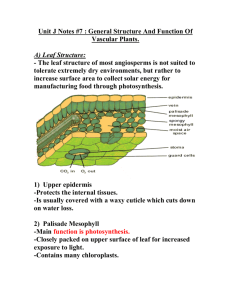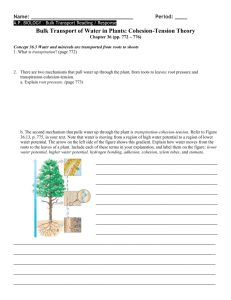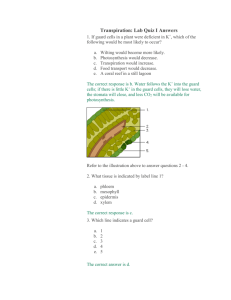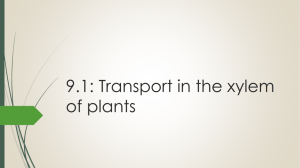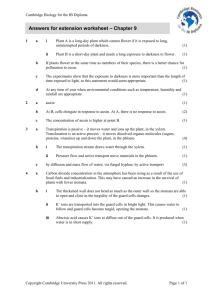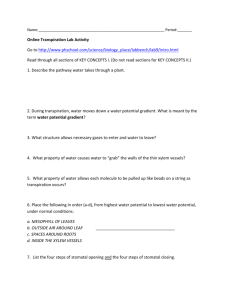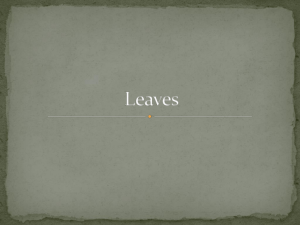Transpiration
advertisement
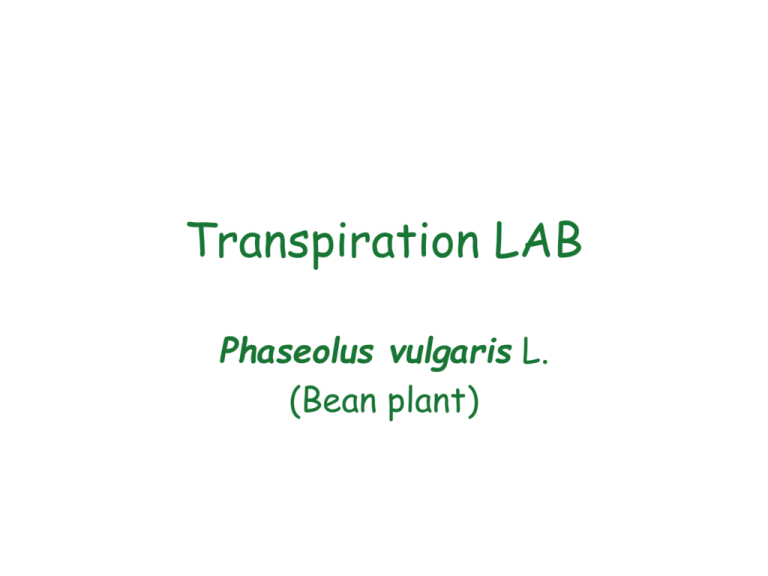
Transpiration LAB
Phaseolus vulgaris L.
(Bean plant)
Objectives
• Investigate the effect of low light and high light
intensity on the rate of transpiration from leaves.
• Investigate the effect of abscisic acid (ABA) on
the rate of transpiration from leaves.
• Make and view slides of plant root, stem, and leaf
sections using bright field and fluorescence
microscopy.
• Examine epidermal peels under the microscope.
PHOTOSYNTHESIS
• 6CO2 + 6H20 + LIGHT ->C6H12O6 + 6O2
•
•
•
•
CO2 intake from the air via leaf
H20 intake by roots and released at leaf
LIGHT sunlight on leaf
O2 released via leaf
Plant Terms…
XYLEM
• Complex vascular
tissue through which
most of the water
and minerals are
conducted from the
roots to other parts
of the plant.
• Cells are dead.
XYLEM ELEMENTS
• *Vessels: Elongated,
cells placed end to
end. Walls at end of
vessel members are
perforated or are
completly missing.
Found in most
angiosperms.
XYLEM ELEMENTS
• Tracheid :
Elongated, thickwalled conducting
cells of xylem,
characterized by
tapering ends and
pitted walls
without true
perforations.
LIGNIN
• Hard supporting material embedded
in the cellulose matrix of plant cell
walls. Makes up xylem inner layer
of cell (secondary) walls
• Second most common plant polymer
• Autofluoresces blue under UV light
Phloem
• Vascular tissue
that conducts
sugars and other
organic molecules
from the leaf to
the other parts of
the plant.
Sieve tubes
• Cells of phloem that line up
connecting leaves, shoots,
and roots.
• Cells contain little
cytoplasm (which is
continuous between cells)
and no nucleus.
• Food materials pass from
one element to another via
sieve plates (perforations).
•Companion cell: a
parenchyma* cell
that controls
metabolic activities
of sieve elements.
PARENCHYMA
• Plant tissue composed of spongy,
living, thin-walled randomly arranged
cells with large vacuoles.
Usually
photosynthetic or storage tissue.
• Most common type of cell in pants
A = Xylem B = Phloem
• Composed of dead cells
• Cytoplasm of one cell joined to
adjacent cells
• Carries water
• Carries sugars and organic molecules
• Wall fluoresce blue under UV light
Root Morphology
• Epidermis ( outer tissue absorbs water and
minerals from soil)
• Cortex (ground tissue of root, storage
parenchyma)
• Endodermis (compact cells with no space
between them & encircled by continuous
band of wax, Casparian strip)
• Vascular Cylinder (xylem & phloem)
Jepson, M. (1966). Biological Drawings with Notes, Parts I &
II. Norwich:John Murray (Publishers) Ltd., pp.22-23.
Casparian strip:
Thickened, waxy strip
that extends around
and seals the walls of
endodermal cells in
roots or plants.
Restricts diffusion of
solutes across the
endodermis into
vascular tissues of the
root.
Vascular Bundle
• Long continuous strands of conducting
tissue in plants.
• Consist of xylem and phloem tissue
close to each other.
Monocot stem
Jepson, M. (1966). Biological Drawings with Notes, Parts I & II. Norwich:John Murray (Publishers) Ltd., pp.22-23.
Jepson, M. (1966). Biological Drawings with Notes, Parts I & II.
Norwich:John Murray (Publishers) Ltd., pp.22-23.
DICOT STEM
Jepson, M. (1966). Biological Drawings with Notes, Parts I & II.
Norwich:John Murray (Publishers) Ltd., pp.22-23.
Jepson, M. (1966). Biological Drawings with Notes, Parts I & II. Norwich:John
Murray (Publishers) Ltd., pp.22-23.
Leaves
• Usually the site of photosynthesis and
transpiration.
• Epidermal cells
• Mesophyll (middle leaf)
– Palisade parenchyma
– Spongy parenchyma
• Stomata (composed of guard cells)
Jepson, M. (1966). Biological Drawings with Notes, Parts I & II. Norwich:John Murray (Publishers) Ltd., pp.22-23.
Stomata
Guard Cells
• Guard cells (special type of
epidermal cell)
• Paired cells attached to
each other at ends
• Stoma/stomata (opening)
• Stoma/stomata (paired
guard cells plus pore)
• Guard cells contain
chloroplasts
Guard Cells
Changes within guard cells control stoma opening.
• FACTORS that cause changes
– Light (blue)
– Temperature
– Relative humidity
– Abscisic acid
– Carbon dioxide
Factors causing stomata to open
• General: Open in day and close at night
• Cues to open at dawn
– Blue-light receptors in guard cell
• Stimulate proton pumps promoting uptake of K+
• Drive photosynthesis and lower [CO2]
– Low [CO2]
– Circadian rhythms (internal clock)
Factors causing stomata to close
• Environmental stress (excessive transpiration)
– Dehydration
– ABA
• High [CO2]
• Temperature (works both ways)
– Increase rate of photosynthesis = [CO2]
– Increase rate of respiration = [CO2]
Cellulose microfibrils arranged in loops around guard cells
and uneven thickness of walls prevent radial expansion
but allows lengthwise expansion.
flaccid
turgid
Keeton, WT & Gould, JL (1986). Biological Science, NY: WW Norton, p. 276.
*Where are the Stoma?
Ave. # Stomata/cm2
Ave. # Stomata/cm2
Upper side
Lower side
Bean
4000
28,100
Apple
0
29,400
1,200
13,000
Leaf type
Tomato
*Robbins, Weier & Stocking (1966). Botany: An introduction to plant science, NY: John Wiley & Sons, p. 145.
Hydropassive Closure
• Low humidity air dehydrates guard cells.
• Guard cells lose tugor and close.
Hydroactive Closure
• Guard cells have CO2 sensors
• Leaf needs CO2 for photosynthesis.
• When CO2 concentration drops, guard cells
gain tugor pressure and stomata open.
• When CO2 concentration increases, guard
cell lose tugor pressure and stomata close.
Hydroactive Closure
• Guard cells have ABA sensors.
• ABA accumulates in chloroplasts of
mesophyll cells.
• Mesophyll becomes mildly dehydrated:
a. Stored ABA released outside of cell so
it can stream to guard cells.
b. Rate of ABA synthesis increases
Abscisic Acid (ABA)
• Originally thought to cause abscission of
fruits.
• ABA can be transported in xylem and
phloem and thus move up and down the
stem.
• ABA production is initiated by stresses
such as water loss or freezing
temperatures.
Some Functions of Abscisic Acid
• 1.
Stimulates the closure of stomata.
• 2.
Inhibits shoot growth (not root).
• 3.
Induces seed to synthesize storage proteins.
• 4.
Inhibits the affect of gibberellins.
• 5.
Initiates and maintains dormancy.
• 6.
Induces gene transcription
inhibitors in response injury.
for
proteinase
What actually causes water
to flow in and out of cells?
• Active transport moves K+ ions in or
out of guard cell.
• Water flows from hypotonic solutions
to hypertonic solutions.
POTASSIUM ION (K+) CONCENTRATED OUTSIDE OF GUARD CELLS.
WATER LEAVES GUARD CELLS. CELLS BECOME FLACCID.
•K
+
Stoma closed
INFLUX OF POTASSIUM IONS INTO CELL.
WATER FOLLOWS. Guard cells become turgid.
Stoma open
http://www.tvdsb.on.ca/westmin/science/sbioac/plants/stoma.htm
Guard Cells & ABA
• Plant water stressed
• ABA released by plant cells
• ABA binds to guard cell
receptors
• Activates signal
transduction pathway
• Lowers solute
concentration in guard cells
• Lowers cell tugor
• Stoma close
malate
++
Ca
+
K
Transpiration
• Loss of water from plant by
evaporation.
• Water loss mainly from leaves.
• Energy for process from sun
Water moves from soil into the root.
•
Water moves from soil into the
root.
•
Water moves from root
xylem into the stem xylem.
•
Water moves from leaf
xylem into mesophyll cells
•
Water moves from leaf
xylem into mesophyll cells.
•
Water vapor inside leaf is lost
via diffusion through stomata.
How is water transported up xylem?
Cohesion-Tension Theory
•
“…Transpiration of a water molecule
•
Curtis & Barnes (1989). Biology, G-5.
results in a negative (below 1 atmosphere)
pressure in the leaf cells, inducing the
entrance from the vascular tissue of
another water molecule, which, (because
of the cohesive property of water), pulls
with it a chain of water molecules
extending up from the cells of the root
tip.”
WATER IS A POLAR MOLECULE!
Properties of Water (H2O)
• Water is a polar molecule.
• Polarity aids water movement in plant:
– Cohesive strength
• (hydrogen bonding, molecules stick to each other)
– Adhesive strength
• (water sticks to other things)
– Tensile strength
• (pulls chain of water molecules sticking to each other)
TACT
{Cohesion-tension theory}
•
•
•
•
T=
A=
C=
T=
Transpiration (loss of water from plant)
Adhesion (hydrophilic attraction to vessel walls)
Cohesion (hydrogen bonding twixt H2O molecules)
Tensile (upward pull creates negative pressure)
Pressure vs. Tension
• Tension opposite of pressure.
• Pressure is exerted in every
direction. Causes a cell wall to swell.
• Tension is a negative pressure. Tends
to pull in walls of a cell.
•
Water vapor inside leaf is lost,
molecule by molecule. via
diffusion through stomata.
•
Water evaporates, molecule by
molecule, from surface of
mesophyll cells into the
intercellular air spaces.
•
As water potential of leaf cell
decreases, water moves,
molecule by molecule, from leaf
xylem into mesophyll cells.
Water moves from stem xylem
into leaf xylem.
Cohesion between water
molecules creates large tensile
strength (140 kg/cm) on thin
continuous column of water.
Water, molecule by molecule,
adhere to inner surface of xylem
vessels.
Water moves , molecule by
molecule, from soil into the root.
A break in the continuous column
of water stops the water from
rising.
State of Stoma
A = Opens B = Closes
•
•
•
•
•
•
Bright Light?
Low level of CO2 in leaf?
Water stress?
High ABA?
High Temperature?
K+ high in guard cells?
STATE OF STOMATA
STOMA OPEN
Guard cells turgid
Bright light
CO2 Low
[ABA] low
K+ High in guard cells
Temperature High
Photosynthesis High
Water Plentiful
STOMA CLOSED
Guard cell flaccid
Darkness
CO2 High
[ABA] high
K+ Low in guard cells
Temperature Low
Photosynthesis Low
Water Stressed
Measuring Transpiration Rate
• Water moves in response to a driving
force:
– Concentration gradient (diffusion)
– Water potential gradient (osmosis)
– Pressure gradient (bulk flow)
• Flow rate determined by several factors:
– Driving force/resistance
– Driving force x conductance
Stomatal Conductance
• As measure of how freely water vapor can
pass from inside a leaf to the outside.
• Conductance in pipes depends upon the
resistance (length of pipe, its radius and
viscosity of the water).
• Conductance in leaves depends upon the
size of the stomata (open/closed) and the
density of stomata on the leaves.
Measuring Transpiration Rate
• Porometer measures the stomatal
resistance of plant leaves (C=1/R)
– Measures transpiration rate by measuring the
resistance to the loss of water vapor through
the stomata.
– Instruments measures the time it takes for a
leaf to release sufficient water vapor to change
the relative humidity in a small chamber by a
fixed amount.
– Using unifoliate leaves
Using Porometer
Stomatal Conductance Measurements
• Conductance = m s-1 or cm s-1
– (in velocity units)
• Conductance = mmol H2O m-2 s-1
– (as mole units)
fini
Movement of water up plant
•
Water moves from soil into the root.
•
Water moves from root xylem into the stem xylem.
•
Water moves from stem xylem into leaf xylem.
•
Water moves from leaf xylem into mesophyll cells.
•
Water evaporates from surface of mesophyll cells into the
intercellular air spaces.
•
Water vapor inside leaf is lost via diffusion through stomata.
Transpiration
1.
Water vapor inside leaf is lost, molecule by molecule. via diffusion through
stomata.
2.
Water evaporates, molecule by molecule, from surface of mesophyll cells into
the intercellular air spaces.
3.
As water potential of leaf cell decreases, water moves, molecule by molecule,
from leaf xylem into mesophyll cells.
4.
Water moves from stem xylem into leaf xylem. Cohesion between water
molecules creates large tensile strength (140 kg/cm) on thin continuous
column of water. Water, molecule by molecule, adhere to inner surface of
xylem vessels.
5.
Water moves, molecule by molecule, from root xylem into the stem xylem.
6.
Water moves , molecule by molecule, from soil into the root.
